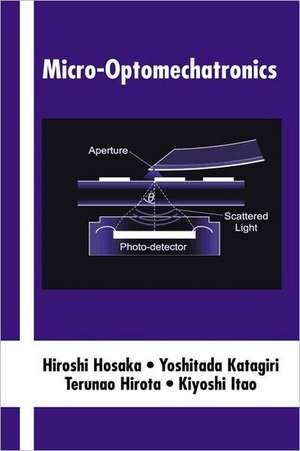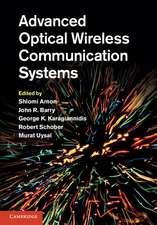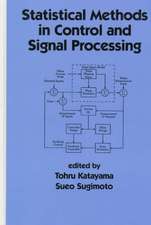Micro-Optomechatronics: Optical Science and Engineering
Autor Hiroshi Hosaka, Yoshitada Katagiri, Terunao Hirota, Kiyoshi Itaoen Limba Engleză Hardback – 15 dec 2004
Contains examples of micro-optomechatronic devices in information and communication systems
Din seria Optical Science and Engineering
- 23%
 Preț: 351.77 lei
Preț: 351.77 lei - 18%
 Preț: 2071.62 lei
Preț: 2071.62 lei - 18%
 Preț: 1390.92 lei
Preț: 1390.92 lei - 15%
 Preț: 489.26 lei
Preț: 489.26 lei - 15%
 Preț: 461.03 lei
Preț: 461.03 lei - 22%
 Preț: 352.95 lei
Preț: 352.95 lei - 15%
 Preț: 585.27 lei
Preț: 585.27 lei - 18%
 Preț: 840.06 lei
Preț: 840.06 lei - 18%
 Preț: 1564.72 lei
Preț: 1564.72 lei - 18%
 Preț: 1938.64 lei
Preț: 1938.64 lei - 18%
 Preț: 1345.30 lei
Preț: 1345.30 lei - 26%
 Preț: 456.63 lei
Preț: 456.63 lei - 15%
 Preț: 461.03 lei
Preț: 461.03 lei - 18%
 Preț: 1232.28 lei
Preț: 1232.28 lei - 26%
 Preț: 461.72 lei
Preț: 461.72 lei - 23%
 Preț: 378.96 lei
Preț: 378.96 lei - 18%
 Preț: 1805.67 lei
Preț: 1805.67 lei - 18%
 Preț: 1308.07 lei
Preț: 1308.07 lei - 18%
 Preț: 1605.61 lei
Preț: 1605.61 lei - 18%
 Preț: 1285.17 lei
Preț: 1285.17 lei - 23%
 Preț: 427.84 lei
Preț: 427.84 lei - 9%
 Preț: 1110.44 lei
Preț: 1110.44 lei - 18%
 Preț: 891.36 lei
Preț: 891.36 lei - 15%
 Preț: 585.27 lei
Preț: 585.27 lei - 27%
 Preț: 1213.99 lei
Preț: 1213.99 lei - 18%
 Preț: 1549.56 lei
Preț: 1549.56 lei - 18%
 Preț: 1557.29 lei
Preț: 1557.29 lei - 15%
 Preț: 461.03 lei
Preț: 461.03 lei - 18%
 Preț: 2899.51 lei
Preț: 2899.51 lei - 26%
 Preț: 479.43 lei
Preț: 479.43 lei - 28%
 Preț: 1578.80 lei
Preț: 1578.80 lei - 15%
 Preț: 624.49 lei
Preț: 624.49 lei - 18%
 Preț: 2207.76 lei
Preț: 2207.76 lei - 29%
 Preț: 1101.89 lei
Preț: 1101.89 lei - 18%
 Preț: 2757.04 lei
Preț: 2757.04 lei - 18%
 Preț: 2511.86 lei
Preț: 2511.86 lei - 18%
 Preț: 1805.46 lei
Preț: 1805.46 lei - 18%
 Preț: 2223.24 lei
Preț: 2223.24 lei - 18%
 Preț: 1394.07 lei
Preț: 1394.07 lei - 18%
 Preț: 1667.19 lei
Preț: 1667.19 lei
Preț: 1211.28 lei
Preț vechi: 1668.99 lei
-27% Nou
Puncte Express: 1817
Preț estimativ în valută:
231.78€ • 241.52$ • 191.91£
231.78€ • 241.52$ • 191.91£
Carte tipărită la comandă
Livrare economică 03-17 aprilie
Preluare comenzi: 021 569.72.76
Specificații
ISBN-13: 9780824759834
ISBN-10: 0824759834
Pagini: 320
Dimensiuni: 152 x 229 x 23 mm
Greutate: 0.55 kg
Ediția:1
Editura: CRC Press
Colecția CRC Press
Seria Optical Science and Engineering
ISBN-10: 0824759834
Pagini: 320
Dimensiuni: 152 x 229 x 23 mm
Greutate: 0.55 kg
Ediția:1
Editura: CRC Press
Colecția CRC Press
Seria Optical Science and Engineering
Public țintă
ProfessionalNotă biografică
Hiroshi Hosaka, Yoshitada Katagiri, Terunao Hirota, Kiyoshi Itao
Cuprins
Preface, Chapter 1 The World of Micro-Optomechatronics, Chapter 2 Technological Outline of Micro-Optomechatronics, Chapter 3 Intermittent Positioning in Micro-Optomechatronics, Chapter 4 Constant Velocity Positioning in Micro-Optomechatronics, Chapter 5 Follow-Up Positioning in Micro-Optomechatronics, Chapter 6 Fundamental Optics of Micro-Optomechatronics, Chapter 7 Fundamental Dynamics of Micro-Optomechatronics, Chapter 8 Novel Technological Stream Toward, Index
Descriere
Micro-Optomechatronics systematically explains the devices based upon the fusion of optics, electronics, and mechanics via MEMS technology. The book first demonstrates how devices are classified based upon the control methods of power and position of the laser beam. It then describes the devices in detail according to the classification of control methods. Positional control is classified as intermittent control, constant velocity control, and follow-up control. The volume concludes with an explanation of the optics and dynamics that provide the theoretical background of control methods, and an overview of the influence of nanotechnology and near-field optical memory.

























